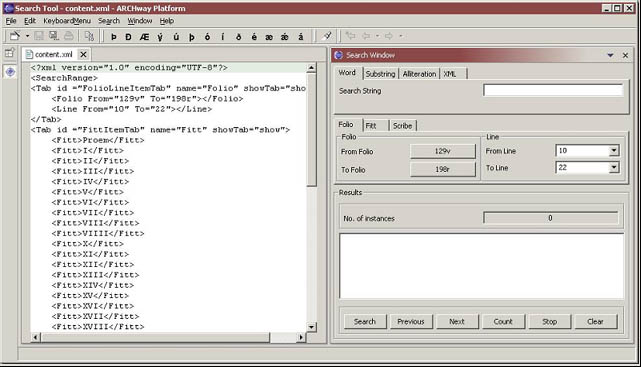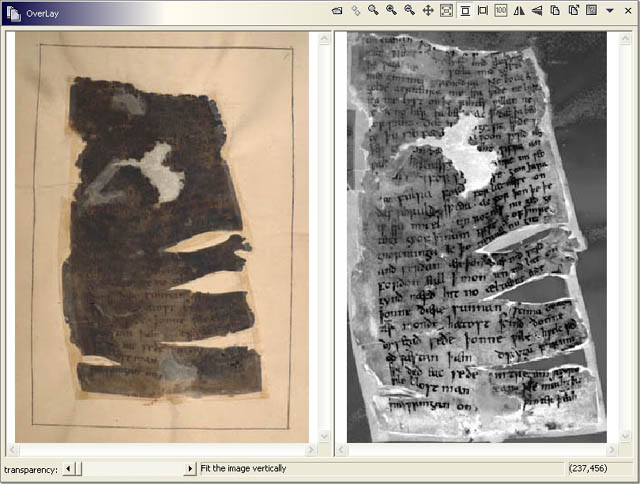Two techniques pioneered in the Electronic Beowulf project are essential for recovering and restoring large sections of text in Alfred’s Boethius. Ultraviolet photography requires long exposure times that can cause damage to a manuscript, not to mention a photographer. We discovered while digitizing the Beowulf manuscript that the digital camera could safely record fluorescent effects in the seconds it took to digitize in normal bright light. The saved images carry an obscuring artifact of the process, a dark overlay on the image, which can be removed through a straightforward image-processing routine. The second technique employs fiber-optic backlighting and a digital camera to reveal and record letters and parts of letters hidden by the nineteenth-century restoration frames of the Cotton collection. The Electronic Beowulf won an award in 1994-1995 for Innovation in Information Technology for developing this process. Although it works with all Cottonian manuscripts whose binding frames cover parts of text, fiber-optic backlighting is not as effective with Cotton Otho A. vi as it is with Beowulf. The bright backlighting reveals wherever text is covered, but ultraviolet cannot penetrate the paper frames to restore or enhance the covered text.
Still under revision by the Committee on Scholarly Editions (CSE), the Modern Language Association’s (MLA) “Guidelines for Electronic Scholarly Editions” promote the use of such encoding norms as Standard Generalized Markup Language (SGML), in particular its subset for markup of electronic texts in the humanities, the Text Encoding Initiative (TEI). Although now converted to XML, the TEI Guidelines for Electronic Text Encoding and Interchange (P4) are not designed for the description of physical features of a document, which of course is indispensable for encoding a damaged medieval manuscript for an image-based electronic edition. We take advantage of what TEI has accomplished, but our requirements go beyond what TEI has addressed. For example, the physical damage to the manuscript requires complex markup that leads to conflicting hierarchies of descriptive tags. To accommodate our markup requirements we are therefore designing software to deal with conflicts automatically. We encode with XML all textual components of Alfred’s Boethius, including the transcription, the edited text, the glossaries, and apparatus, and will use Extensible Style Language Transformations (XSLTs) to provide multiple viewing options. A native XML database with a powerful XPath processor will store the encoded documents and extensively linked images to facilitate comprehensive searches of all content, from glossary to manuscript transcript with linked images to the full editorial apparatus, through a user-friendly interface.
Commercial SGML/XML-aware software is not only prohibitively expensive, but also limited to specific purposes. Most textual scholars in the humanities must accordingly rely on open source software, non-proprietary software for which the source code is freely available. Open source software, however, also requires the support of applications programmers and interface designers to adapt it for changing purposes and to maintain it over time. To address these perennial barriers, we are designing software that is extensible and adaptable without the need for new programming. We are using a modular Java and XML software framework, including an edition production management system, a native XML database, configurable interfaces, and a suite of reusable editorial tools, customized to the needs of textual scholars in the humanities. This extensible toolkit will facilitate the efficient assembly of complex scholarly editions from high-resolution digital facsimiles and XML-encoded texts, apparatus, and ancillary materials. The Edition Production Toolkit (EPT), now in development as Edition Production Technology under the auspices of The ARCHway Project: Architecture for Research in Computing for Humanities through Research, Teaching, and Learning, will be refined as we build the electronic edition of Alfred’s Boethius. When completed, EPT will be freely available to scholars in the humanities for other projects.

[Adaptable Search Window GUI through an XML file]
Since 1996, when the RLG issued Preserving Digital Information: Report of the Task Force on Archiving of Digital Information, progress has been made toward establishing standards for ensuring long-term preservation of and access to digital resources. One of the new standards most widely-embraced by the library and archival community is the METS: Metadata Encoding and Transmission Standard, an initiative of the Digital Library Federation. METS allows the creator of a digital library (in our case, digital edition) to combine different types of metadata in one document, using the XML schema language. Following the endorsement of METS, the Electronic Boethius Project will also use MODS: Metadata Object Description Schema for descriptive metadata and NISO's MIX: Metadata for Images in XML Schema for technical image metadata. For technical text metadata we expect to use "Schema textmd.xsd," the Schema for Technical Metadata for Text under development at NYU. The METS document for Electronic Boethius will also include a Behavior Section describing the computer programs required to run the edition and a Structural Map outlining the hierarchical structure of the edition. This project will continue to research emerging options for the descriptive, administrative, and structural metadata required for long-term preservation of the electronic edition.




 Home
Home